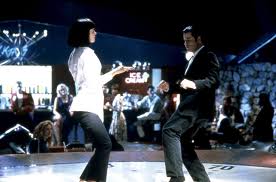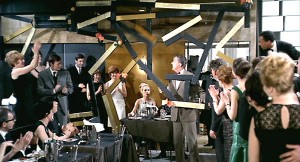The concluding chapter of my book Movie Wars: How Hollywood and the Media Limit What Films We Can See (Chicago: A Cappella Books, 2000).
Due to the length of this Conclusion, it’s being posted in two parts. — J.R.
Conclusion: The Audience Is Sometimes Right
“What is your feeling towards your audiences — towards the public?”
“Which public? There are as many publics as there are personalities.”
— Gilbert Burgess, “A Talk with Mr. Oscar Wilde” (1895)
QUESTION: Aren’t you laying yourself open throughout this book to the charge of sour grapes?
ANSWER: What do you mean?
Q: I mean attacking critics like Janet Maslin and David Denby because you’d so obviously like to have their jobs yourself.
A: If that’s really your impression of what lies behind my arguments, then my arguments have failed. There’s a hefty price tag for whatever prestige and power comes with writing for The New York Times and The New Yorker, and I consider myself fortunate that I don’t have to worry about paying it. Film critics for those publications — including Vincent Canby and Pauline Kael as well as Maslin and Denby — ultimately wind up less powerful than the institutions they write for, and insofar as they’re empowered by those institutions, they’re disempowered as independent voices.
Q: You don’t mean to suggest that they’re told what to write?
A: Not at all — though they certainly don’t get as much space as I do in the Chicago Reader, and it’s questionable whether they have the same amount of freedom. Their limitations are built into the meaning and perceived function of their positions. There’s a terrible feeling of resignation regarding the status quo of taste in those publications — the usual assumption that the public is a pack of idiots, which Anthony Lane treats as an occasion for jokes, for instance. And part of the resignation comes from the conviction, no doubt based on experience, that many readers want to be advised by The New York Times or The New Yorker, not by whoever happens to be writing for either outlet.
In a letter that Orson Welles once wrote to Peter Bogdanovich about the obfuscations of Kael in The New Yorker regarding the authorship of the Citizen Kane script, he compared his dilemma to that of someone with gloves on trying to clean up shit: the gloves, he noted, wind up getting shittier, but the shit doesn’t get any glovier. That’s a rude metaphor, and I don’t mean to imply by it that those publications are the equivalent of shit. But it’s also a very helpful metaphor, because it implies — correctly, I think — that the institutional power of The New York Times and The New Yorker is substantially greater than that of any individual who winds up writing for either of them. No matter how bright, resourceful, or independent the writer is, the voice of the publication is ultimately stronger, and over time it winds up having the final say on matters of taste.
That’s what Sam Fuller meant when he told me in 1987, “If Vincent Canby got fired from the Times today, and he went to a bar and started talking about a movie he had just seen, nobody there would give a fuck what he thought. They’d probably just tell him to shut up.” That’s another rude way of putting it, but it’s important to acknowledge that the exercise of power in such matters always tends to be rude, whether in the short run or over the long haul.
Certainly I have my quarrels with how Maslin and Denby, among others, have wielded their various forms of institutional power on occasion — especially because their preeminence as reviewers often seems to be gauged by the scant amount of world cinema they see or are even interested in seeing, which presumably puts them on an equal footing with their fans. But that doesn’t mean that the institutional powers they enjoy are neutral factors in this process.
On June 4, 1999, an article by Sarah Kerr entitled “Janet Maslin: Why Can’t the New York Times Movie Critic Tell Us What She Really Thinks?” was posted by the online magazine Slate. Kerr, who writes some of the capsule reviews of films for The New Yorker, was evidently moved to ask this question after reading Maslin’s “overall rave” about The Phantom Menace, a film she finds “dull and annoying and occasionally rather offensive”; the issue of Maslin’s lack of knowledge about or interest in most of the foreign films at Cannes or elsewhere, for instance, never comes up. But Kerr still concludes that Maslin “has developed a disembodied, ghostly way of writing about movies — a criticism of lowered expectations. Her main defense of the disappointing Phantom Menace? It’s ‘only a movie.’ Exactly — and while we’re at it, Maslin is only a critic who asks for too little.” Which is another way of addressing the alienation that I’ve been discussing throughout this book, although it’s not surprising that Kerr winds up expressing part of that alienation herself, apparently without realizing it. My definition of a critic who asks for too little is one who’s sufficiently indifferent about world cinema to trust a distributor or a festival director for a comprehensive account of it; and that seems to describe Maslin and Kerr equally, judging by what they write. If, on the other hand, the index of your higher expectations is whether or not you like The Phantom Menace, then it isn’t very high in the first place.
Kerr rightly notes that Maslin often appears to be writing not from her own point of view but from an attempt to “[gauge] in advance the public’s reaction,” which winds up expressing “the impression the studio hopes the film will have on an audience.” Notice how the line of assumed thinking here proceeds directly, without a bump or a burp, from anticipating audience reactions to anticipating the studio’s hopeful projections of these reactions — a succinct example of the kind of alienation I’ve been concerned with, where the audience somehow gets absent-mindedly displaced in the transaction. And I don’t think it would be unfair to say that Kerr’s analysis ultimately displaces the audience to the same degree as Maslin’s attitude: after all, she and her editors and Maslin and her editors all have much more common ground than the unknown and unknowable audience, some members of which probably even like The Phantom Menace as much as Maslin professes to.
Q: Now you’re really confusing me. Are you defending Maslin’s defense of George Lucas?
A: Not necessarily. To tell the truth, I didn’t bother to read that review, apart from the bits that Kerr quoted — if only because what I usually find most alienating as well as alienated about Maslin’s reviewing is her efforts to anticipate other people’s reactions, which often seem to matter much more to her than her own. That’s partly what Kerr is writing about, and she’s accurate about that charge. But Kerr’s reactions to The Phantom Menace, as expressed in this article, don’t seem much more interesting or vital to me, even if they’re closer to mine. And the pre-empting of the audience’s voice in this matter is not a problem that’s going to vanish, regardless of who’s writing about the film or where they write it or what they say. After all, Anthony Lane wrote one of his funniest demolition jobs for The New Yorker on The Phantom Menace, but what he had to say was no more in tune with the film’s audience than what Maslin or Kerr had to say; to my mind, it was just as much an expression of alienation from the status quo of film culture as anything else I read about the movie, and I wasn’t surprised when The New Yorker subsequently published a letter from an irate reader accusing Lane of elitism.
Q: What, then, would an unalienated review of the movie have consisted of?
A: Your guess is as good as mine. None of us reviewers has an option of that kind available nowadays because none of us has a clue about what the mass audience consists of. Maybe over time we’ll get some indications. I was intrigued by the remarks of a grad student at Stanford who attended the movie’s first screening there, at midnight. He suggested that many of the biggest Star Wars buffs were disappointed, but not in the same way that reviewers such as Lane, Kerr, and Robert Hughes were, who weren’t speaking to their constituency. I’m not saying it’s necessarily the job of reviewers to address constituencies — which is what Maslin and Ebert were attempting to do in their own favorable notices. But it might help
for starters if reviewers realized how little they know about such matters — and how little studios know apart from what allows them to do their business (which they don’t always know as well as they claim to, either).
It’s the equation of business calculations with a presumed knowledge of an audience’s desire and capacities that leads to all the alienation I’ve been talking about — a factor that no one can escape entirely because all other gauging instruments have been factored out of the mainstream, ruled out of order. I was amazed when I watched Ebert and Kenneth Turan on Ebert’s TV show the week after Cannes, when they reiterated their horror about the final prizes and spoke about some of the films they liked. At one point Turan remarked that what was great about attending Cannes was being able to spend eleven days watching movies without having to worry about the film business. I’m sure he was being sincere about this and that it didn’t occur to him that a substantial part of what he wouldn’t even think of seeing at Cannes would be screened out of his consciousness precisely because of the film business he claimed he wasn’t thinking about.
Q: There’s nothing wrong with mainstream critics speaking to the interests of mainstream viewers. Why should we try to get them interested in esoteric art movies?
A: This assumes that the line separating “mainstream” from “esoteric” is always easy to spot and difficult to refute. Sometimes it is and sometimes it isn’t. Once upon a time, Citizen Kane was regarded as esoteric — something I touch on in the previous chapter. If this country didn’t have a lot of independent art theaters when Open City and Paisa got released in the mid-forties, those movies would have been written off as esoteric as well, and I can’t believe they’re any more specialized than some of the Iranian and Taiwanese films being treated as “esoteric” today — films which will remain “esoteric” only as long as conservative critics and distributors ensure their unfamiliarity by treating them that way.
I also happen to believe that servicing mainstream interests, which is a more complex job than it’s often cracked up to be, shouldn’t rule out servicing more specialized interests, even within mainstream media; there’s no reason why there can’t be room enough for both. Unless the studios claim that they’re not getting enough attention — which they and their mouthpieces are always claiming (cf. the complaints about the 1999 Cannes prizes) — and mainstream editors and producers insist on catering to these demands, which is unfortunately what happens. And then, in order to justify this callow behavior, the claim is made that this is all the mass audience cares about anyway. But any reviewing or journalism worth its salt is about more than catering. It should also be about cultivation and education and offering the public choices. And it should address itself to which choices are supposedly being made on behalf of the public: the kind of movies that wind up in theaters versus the kinds that don’t. These considerations get elided at the outset, and when other possibilities are proposed, our equivalent to the politburo gets hysterical.
Q: I take it you’re referring to the Harvey Weinstein support group again, a particular fixation of yours. What I don’t understand about your objections to Weinstein is that his methods correspond in a good many particulars to those of Irving Thalberg, Louis B. Mayer, Darryl F. Zanuck, and Harry Cohn — the studio chiefs in the golden age of Hollywood who gave their own personal stamp to their products. Weinstein obviously cares about his movies in the same way, and certainly his passion is preferable to the faceless accountant mentality that characterizes most of the rest of the business.
A: Your objections remind me of those that film historian Thomas Elsaesser made to me when I showed him an earlier polemic of mine about the Weinstein brothers and Miramax. (1) In effect, Thomas told me I should get down on my knees in gratitude to someone like Weinstein because of all the vitality and excitement he was bringing to a moribund business — the same sort of argument Maslin made to me on another occasion. Maybe if Weinstein were producing the same sort of factory products as his predecessors his methods would be more defensible, but in most cases he isn’t. It’s also worth stressing that filmgoing habits are radically different today from what they were in the studio era. Back then, people went to the movies out of habit and as a matter of course, so the main aim of the industry was to service that taste and furnish theaters with a lot of product. Today they’ll only go to a movie if something or someone guides them there — advertising, “coverage,” a review, a general buzz, anything that makes the appearance of that movie an event. And what I’m mainly concerned with in this book is how such events get defined and regulated — even policed.
I’ll grant that Harvey Weinstein may provide the sort of paternalistic guidance and counterforce that someone like Quentin Tarantino benefits from, so it’s entirely possible that Reservoir Dogs, Pulp Fiction, and even Jackie Brown — which I’m told Miramax shortened by about half an hour — are better than they might have been without his input. I’m not trying to suggest that Weinstein is wrong about everything, any more than I think that Maslin was. (I liked her enthusiastic review of Lovers of the Arctic Circle, for instance — which wasn’t, by the way, a Miramax release. And I also happen to admire the gracefulness of Denby’s prose style at the same time that I lament the narrowness and provincialism of his critical taste.) Sometimes Weinstein is simply trying to make a noncommercial movie more commercial in ways that I can appreciate, even if I don’t agree with him, and plenty of other distributors behave the same way.
But the terrible irony is, the more enthusiasm that Weinstein feels about one of the movies he’s distributing, the greater the odds are that he’ll wind up tampering with it. The usual situation appears to be that if he likes it he thinks he can improve it, which is apparently why he wound up recutting Chen Kaige’s Temptress Moon — a film that I liked for its hypnotic rhythms when I saw it at Cannes but found tedious after Miramax recut it and added explanatory titles. (For me, it was something like a fever dream that got depoeticized and lost much of its style once it was decided that the audience had to be able to follow the plot with greater ease.) And if Weinstein doesn’t like a film enough to want to recut it, he often won’t make it available to most people, despite the fact that he supposedly distributes it. In the case of Bertrand Tavernier’s 1994 Le fille d’Artagnan [D’Artagnan’s Daughter], this was a matter of proposing certain cuts that Tavernier didn’t agree to. To his credit, Weinstein eventually released the film’s original cut—but only on video, five years later, retitled Revenge of the Musketeers. Even this is better than the treatment he has accorded so far to Abbas Kiarostami’s Through the Olive Trees, made the following year, which has effectively made the film all but impossible to see, even on video.

But the story gets worse. Shortly before this book went to press, a letter arrived from Joel Shepard, film and video curator at San Francisco’s Yerba Buena Center for the Arts. Hoping to show Kiarostami’s so-called “Earthquake trilogy” of Where Is the Friend’s House?, Life and Nothing More, and Through the Olive Trees at his contemporary art museum, he promptly ran into a brick wall acquiring the latter film from Miramax:
When I called Miramax to book the print, I was informed that their sole surviving print had been destroyed. When I asked when they were going to make another print, they responded that it was “unlikely another print would ever be made.” This means there are no prints of this masterpiece available in the United States. I’m going to have to get a print from Alliance in Canada for my playdate.
Just thought you might be interested in yet another piece of evidence of how Miramax is destroying so much world cinema in the United States.
To be fair, one of the sources of this gruesome behavior might have been the scheme by which Miramax was forced to buy the U.S. rights to Through the Olive Trees in the first place — a well-intentioned idea by a film lover that unfortunately backfired. Miramax was determined to distribute the Australian crowd‐pleaser Muriel’s Wedding, and it was offered as part of a package that also included the Kiarostami film, thereby forcing them to take it. Ironically, this is the same ploy that I’m told Miramax has used with var-‐ ious independent theaters: if someone wants to book a particular film from them, they sometimes have to book another film as well that they may not want to show.
No American distributor picked up Leos Carax’s Lovers on the Bridge which when it was released in France a decade ago. There were special screenings of that movie in New York and Chicago that had to turn away crowds of people, and hardly a month went by since then that someone didn’t ask me if the film was ever going to become available again. Miramax eventually responded to this interest by becoming its distributor after its price went down, and in a report put together by Pat Dowell for National Public Radio’s “Morning Edition,” Weinstein suggested that he did this not in order to make money but to serve the interests of film lovers. But in the
same report Dowell noted that Miramax dumped the film during its Washington, D.C. engagement, so that it had no ads and no reviews, ensuring that it died a quick death. “Representatives of Miramax say this was just an error, not a lack of support,” Dowell added; to me it looks like further evidence of the company’s highly sporadic record. It’s the sort of arbitrary exercise of power I associate with Stalinist Russia, where a certain number of important films were subsidized by the government and then banned. In those cases, the press was blocked from protesting by censorship and threats of reprisals. But when Miramax suppresses work today that’s every bit as important, who in the American mainstream would even dream of mentioning the fact, much less raising an objection? Which means that neither the audience nor the work is respected — only the philistine who releases or withholds it and the money that he (not we or the filmmaker) may or may not make from it.
Some of Weinstein’s defenders argue that if he picks up certain films only because he doesn’t want to allow his competitors to make money off them, that’s perfectly OK because it’s simply part of the capitalist game. But does that mean that if a distributor theoretically found a way of making more money by buying, say, a Woody Allen or a John Sayles movie and then giving it an extremely limited or unpublicized American release, that Roger Ebert would necessarily go along with this ruse and not mention the movie on his TV show? That’s what happened with films by Demy, Tati, Kiarostami, and Tavernier, to cite only four examples. (It also happened to another Tati film, Playtime, which received its initial U.S. showing in Queens, three years after it was completed, and wound up as a tax write-off; it wasn’t until much later that the film opened “normally,” and by that time Tati was bankrupt and had no control over the particular versions that were playing in the states.) I know that Roger dislikes Taste of Cherry, the only Kiraostami film he’s seen, but he’s written about Tati with a great deal of reverence. What, then, are we to make of the decision of his TV show not to review the color Jour de fête or Demy’s The Young Girls of Rochefort once Miramax decided to give them only limited releases? That they’re less worthy of attention than all the other Miramax films that were reviewed? Was it because Miramax’s decision to dump these films automatically made them too marginal? Or was it simply a matter of Miramax not cooperating by making clips available? I don’t know the answer to these questions, but I do know that Miramax’s own priorities wound up coinciding precisely with the priorities of Siskel & Ebert, and that these four examples are far from being the only ones I could cite.
A lot of the objections I’m raising are admittedly nothing more than objections to some of the pitfalls of capitalism, which mainstream reviewers seem to have a vested interest in either ignoring or mindlessly rubber‐stamping. Why companies like Miramax should be granted infinitely more respect than the filmmakers whose work they handle continues to baffle me.
***
Q: I notice you’ve made a couple of cracks in this book about the way films are written about in The New York Review of Books. How would you improve the situation?
A: The only way it can ever be improved is for film criticism to be treated as a respectable discipline, at least theoretically. I realize that the lack of seriousness shown by most film reviewers toward their work makes this a dicier matter in quarters like The New York Review, where it must seem both reasonable and normal to assign film reviews or reviews of books about film to people like Gabriele Annan or Louis Menand when The New Yorker does the same thing with Anthony Lane and nobody even blinks. (Admittedly, The New York Review also gets more knowledgeable people on occasion — people like Joseph McBride, Michael Wood, and Geoffrey O’Brien — and nobody beats The New York Times Book Review for sometimes assigning film books to reviewers whose qualifications are close to zero.)
The problem is, in most of the magazines and journals, film criticism is so little respected that anyone with a name or the right connection winds up getting a crack at it, often with lamentable results. And consider the way that success is often gauged in reviewing movies for newspapers. In many cases, the more success you have, the less space you’re allotted. When Dave Kehr went from the Chicago Reader to the Chicago Tribune in the mid-eighties, he lost a good half of his space; then, when he graduated from the Tribune to the New York Daily News, his space was cut roughly in half again. Almost the same thing happened when he surfaced on the Web on CitySearch, and each time his salary went up when his word count went down!
Something comparable happened when John Powers went from the L.A. Weekly to Vogue. In terms of money and power and prestige, each of these moves could be interpreted as a step up — the capacity to write less and less — and the point at which you get on television and are allotted only sound bites, you take off into the stratosphere. (As one of the Times’s arts reviewers noted recently, off the record, “People believe that reading the Times makes them classy — same with The New Yorker. . . . Yes, they’re very willing to believe that somebody is a great writer because he writes for the publication that makes them feel classy.”)
How could film criticism be perceived as an honorable activity under such circumstances? By reading it. By believing that understanding movies better is desirable. But so many other interests get in the way of that belief — social, commercial, professional, recreational — that it currently operates mainly as a cult activity. And it will continue to operate that way until a few insightful editors wake from their slumbers.
I have nothing against cults, by the way. And since I survive in part as a cult writer, it’s a good thing I don’t. But I can’t believe it’s simply the taste of the public as an unalterable condition that sustains this prejudice against film criticism; that certainly isn’t the message I get from my readers. It’s the taste and stamina of certain editors, most of whom apparently don’t know where to look.
Look at the annual collection recently launched by George Plimpton and Jason Shinder, The Best American Movie Writing, published by St. Martin’s Griffin. There’s practically no serious film criticism at all in the 1998 volume; it’s mainly puff pieces and think pieces (including, incidentally, Sontag’s “A Century of Cinema”), memoirs and literary pieces about film. One of the only film critics included is Powers, and significantly he’s incorrectly identified on the contributors’ page as the playwright of the same name. Actually, Powers was one of the better critics around until he recently gave up his job to move to Singapore, but he’s obviously in foreign territory here; one suspects that if Plimpton knew he was a critic and not a playwright, he might not have been included.
Q: Sounds to me like sour grapes again.
A: Not at all — at least not because I feel personally excluded. In fact, a piece of mine just appeared in the 1999 volume, edited by Peter Bogdanovich. Yet it seems pertinent that the article of mine that he picked — and I submitted several, at his invitation — doesn’t qualify as film criticism. It’s a factual piece about the reconfigured Touch of Evil. I know Peter wanted to include something about that, so I can’t really fault him for making that choice. But when I think about some of the knowledgeable, original, and highly literate film critics writing in this country — people like Janet Bergstrom, Natasa Durovicová, Tom Gunning, Miriam Hansen, J. Hoberman, Kent Jones, Dave Kehr, Bill Krohn, James Naremore, Gilberto Perez, Donald Phelps, and Lesley Stern, among many others — I can’t understand why none of them is likely to turn up in any of the volumes, at least the way the series presently appears to be conceptualized. Could it be because these writers know too much about movies? If this was The Best American Sports Writing, I can’t believe that contenders would become disqualified if they knew too much about sports, so I guess that movies have even less cultural status in the United States than sports do. I realize that slightly over half the names in my list are full‐time academics, so one could surmise that it might be the language of some of them that keeps them out — if, that is, the editors were surveying academic film writing. But it’s obvious that they aren’t, because a “select directory of film magazines” published in the back of the 1999 volume of The Best American Movie Writing, containing eighty‐four titles, manages to exclude most of the leading academic film journals, including Cinema Journal, Film Criticism, Film History, Jump Cut, October, Quarterly Review of Film Studies, Persistence of Vision, and Wide Angle. (Among nonacademic film magazines, they manage to exclude Filmmaker, The Independent, and Scenario, while including such oddities as the San Francisco Chronicle, but no other newspapers — just to show you how haphazard the whole thing is.) It’s obvious that no film academic worth his or her salt was even consulted on this list, and I’m afraid this is absolutely typical of the lack of communication between various sectors of the film world that I discuss in Chapter Five.
To be fair to Peter, he did include one academic piece, by Elizabeth Abele, that deals with feminist film theory — a radical gesture in these quarters that should be applauded. And there’s certainly much more criticism found here than in the previous volume, though nothing that deals even remotely with contemporary world cinema. To account for that absence, there’s Denby’s handy end-of‐cinema lament, “The Moviegoers,” just as one found Sontag’s end-of-cinema lament in the first volume; to keep Taiwanese and Iranian cinema out of the third and fourth volumes, I guess they’ll have to scrounge up a couple of more apocalyptic pieces of this kind. David Thomson, who can write about his “discovery” of Ang Lee and Taiwan without even mentioning Hou Hsiao-hsien, Edward Yang, or Tsai Ming-liang, would be the perfect candidate for writing such a piece. Like Denby, he’s popular among people who don’t know or care much about movies (including Janet Maslin, who gave Thomson’s unresearched and misinformed book Rosebud a rave) precisely because he makes everything seem so tidy: Denby’s implication that there are only five or ten foreign movies a year worth thinking about, all of them already high-profile items, is, ideologically speaking, almost identical to Thomson’s statement that Orson Welles “always liked his revolutionaries to be sophisticated and well-heeled.” The fact that both statements are completely untrue is irrelevant; what matters is that they’re comforting and make you feel classy.
Q: Surely this is a matter of opinion, not fact.
A: Yes, but whose opinion? I recently got back from a four-day conference on unfinished Welles films in Munich, and I don’t think it would be an exaggeration to say that well over half of the best Welles scholars in the world were present, from eight countries. As far as I could tell, no one there took Thomson’s Rosebud even halfway seriously: the book never came up in the discussions I attended except as an example of the kind of misinformation about Welles that continues to circulate. Yet one of the regular writers in Film Comment wrote that Thomson deserved a Pulitzer prize for writing it. Why? I guess the book must have made him feel classy.
(to be continued)



















